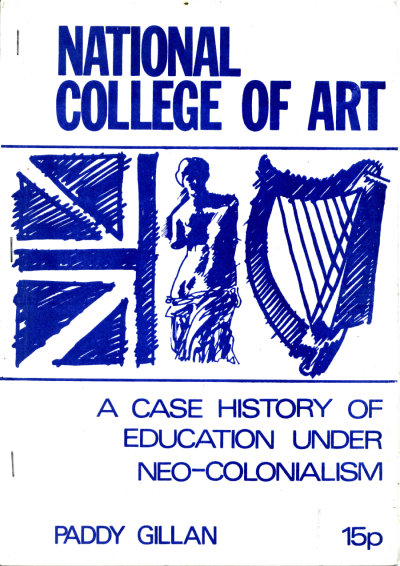National College of Art: A Case History of Education under Neo-Colonialism

| Date: | 1971 |
|---|---|
| Organisation: | National College of Art Students Union |
| Author: | Paddy Gillan |
| View: | View Document |
| Discuss: | Comments on this document |
| Subjects: |
Please note: The Irish Left Archive is provided as a non-commercial historical resource, open to all, and has reproduced this document as an accessible digital reference. Copyright remains with its original authors. If used on other sites, we would appreciate a link back and reference to The Irish Left Archive, in addition to the original creators. For re-publication, commercial, or other uses, please contact the original owners. If documents provided to The Irish Left Archive have been created for or added to other online archives, please inform us so sources can be credited.
Commentary From The Cedar Lounge Revolution
27th May 2013
Many thanks to the person who donated this to the Archive.
This document was published by the Student Union of the National College of Art in Dublin (later the NCAD), and written by Paddy Gillan. The dedication is suggestive of its political provenance:
To Cathal Goulding, house-painter, who spoke at a student seminar in November 1970; trusting that he and his fellow tradesmen will find it of value to apprentices.
As the acknowledgements explain, the ‘pamphlet is, primarily, the result of a seminar - “Art and Society” which was held in the NCA in November, 1970’. It notes that ‘The theoretical guidance of speakers at the seminar - in particular, Jack Dowling, Lelia Doolan, Seamus O Tuathail and Eoghan Harris - helped enormously in my attempt to analyse the NCA situation’
And continues:
‘For advice and help in writing this pamphlet, I am indebted to Nell McCafferty, Anne Harris and John Armstrong’.
It is broken up into five chapters or sections and attempts to give an overview of the NCA and its then situation. At that time the College was situated as part of the Leinster House complex between ‘Dáil Éireann and the National Library in what were once the stables of Leinster House’. The Overview notes that at the time 120 students were in attendance in the institution, ‘eighteen class-rooms existed in the College, many of which are closed, necessary equipment is scarce. Rules and regulations governing the use of such equipment as exists result in it lying idle more often than it is in use. Maintenance of the NCA is in the hands of the Board of Works. The building is patrolled each night by a military picquet; the attitudes to academic discipline reflect this’.
The Background suggests that from its inception to the 1920s:
The school [Metropolitan School of Art - as was] was a colonialist institution. The work conducted in [it] was a mixture of Graeco-Roman and English art-decorative traditions. This was actualised in the form of individual art-objects - drawings, paintings, sculptures - and multiple craft objects which were for private consumption. The actualisation took place in a British colony, the people were politically, economically, culturally and educationally oppressed. The staff and students of the school were, essentially, privileged and their function was to serve the cultural needs of the beneficiaries of colonialism in Ireland - the British, Anglo-Irish and upper-middle class sections of the community. As it served an elite minority, the school was neither a proper cultural or educational establishment because proper culture and education must serve and relate to the whole of a community; furthermore, it was almost totally isolated from the community. Elitism and isolation continue to affect the NCA.
There is much more, not least an interesting insight into the history of the NCA Students Union, formerly the NCA Students Representative Council, which is criticised for having formerly:
..concentrated purely on social affairs. Apart from meeting at social functions, NCA students were effectively disunited and disorganised within the College… student general meetings were rarely held; when they were, it was to discuss the Annual Art Ball.
But the account of developments in the 1967 to 1971 period gives - perhaps - an echo of events occurring further afield, not least in the form of student boycotting of classes due to conditions in the NCA in relation to lack of staff and resources culminating in a ‘work-in’ in February 1969 (there’s an entertaining reference to Brian Lenihan, then Minister of Education, being forced ‘to leave a meeting at TCD through a toilet window after repeatedly refusing to state why he had closed the NCA [on foot of student actions]’. In April there was an occupation of the NCA and the following year there was another occupation and by January 1971 NCA students were picketing the Department of Education on a daily basis and further occupations ensued. The final section, Beyond History addresses further the issue of neo-colonialism and the position of the NCA within that context. The pamphlet also gives a sense of the times and the attitude to cultural areas within the state. There’s one telling quote from Terry Kelleher in Hibernia from 1970:
The crux of the matter is that the NCA is not economically productive in the way that a school of engineering or college of technology can be. Neither is the College a vote-catching issue.
Comments
You can also join the discussion on The Cedar Lounge Revolution
No Comments yet.
Add a Comment
Comments can be formatted in Markdown format . Use the toolbar to apply the correct syntax to your comment. The basic formats are:
**Bold text**
Bold text
_Italic text_
Italic text
[A link](http://www.example.com)
A link